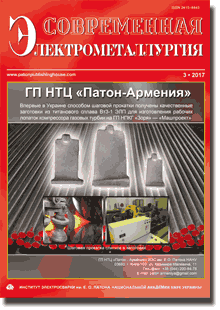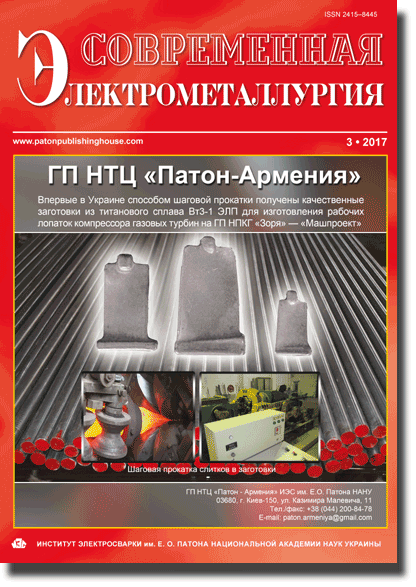| 2017 №03 (05) |
DOI of Article 10.15407/sem2017.03.06 |
2017 №03 (07) |

Electrometallurgy Today (Sovremennaya Elektrometallurgiya), 2017, #3, 33-42 pages
Peculiarities of formation of 3D structure of S460M steel product in additive metallurgical technology
V.A. Kostin, G.M. Grigorenko
E.O. Paton Electric Welding Institute, NASU.11 Kazimir Malevich Str., 03680, Kiev, Ukraine. E-mail: office@paton.kiev.ua
Presented are the results of modeling of temperature fields, kinetics of deposition of liquid metal layers, parameters of cooling and nature of structural transformations in formation of additive structure of steel S460M. To perform the computer modeling, the calculation package COMSOL was used. During the work the following effect: of temperature on physical-chemical parameters of steel in arc heating, heat, induced by molten wire, and kinetics of structural transformations, was taken into account. For modeling the values of conditions close to optimum for electric arc welding of high-strength low-alloy steels were used. The carried out investigations showed that the account for effect of heating of steel S460M by arc source leads to noticeable increase in temperature in the area of layer being deposited (up to 1800…2000 oC) and significant widening of heat-affected zone (up to 20…25 mm). In the offered technological condition of arc deposition the analysis of fields of isotherms did not show the penetration of substrate at the absence of heating by arc source and showed the negligible penetration of the substrate to 0.1…0.2 mm at the account of combined heating by arc source and metal of the molten wire. Kinetics of structural transformations in steel S460M in the additive process of formation of layers was studied. It is shown that the highest rates of cooling ( up to 40…45 oC/s) are formed at the edges of layers being deposited, that leads to the formation of up to 5 % of martensite component at these regions, which increases the risk of formation of cracks and deposit delamination. The developed software can be used for mathematical modeling of metallurgical additive process of formation of structures of steels, titanium, aluminium and other alloys. Ref. 12, Table 1, Figures 9.
Key words: additive production; modeling; structural steel S460M; deposition; structural transformations; microstructure
References
- Zhukov, V.V., Grigorenko, G.M., Shapovalov, V.A. (2016) Additive manufacturing of metal products (Review). The Paton Welding J., 5–6, 137–142. https://doi.org/10.15407/tpwj2016.06.24
- Akhonin, S.V., Vrzhizhevsky, E.L., Belous, V.Yu., Petrichenko, I.K. (2016) Electron beam 3D-deposition of titanium parts. Ibid., 5–6, 130–133. https://doi.org/10.15407/tpwj2016.06.22
- Korzhik, V.N., Khaskin, V.Yu., Grinyuk, A.A. et al. (2016) 3D-printing of metallic volumetric parts of complex shape based on welding plasma-arc technologies (Review). Ibid., 5–6, 117–124. https://doi.org/10.15407/tpwj2016.06.20
- Slotwinski, J. A., Garboczi, E. J., Stutzman, P. E. et al. (2014) Characterization of metal powders used for additive manufacturing. of Research of the National Institute of Standards and Technology, 119, 460–493. http://dx.doi.org/10.6028/jres.119.018 https://doi.org/10.6028/jres.119.018
- Ding, D., Pan, Z., Cuiuri, D., Li, H. (2015) Wire-feed additive manufacturing of metal components: Technologies, developments and future interests. J. Adv. Manuf. Technol., 81(1), 465–481. https://doi.org/10.1007/s00170-015-7077-3
- Bandl, E., Bayfeld, B., Leyens, C., Gault, R. (2010) Additive manufacturing of Ti–6Al–4V using welding wire: Comparison of laser and arc beam deposition and evaluation with respect to aerospace material specifications. Physics Procedia, 5, 595–606. https://doi.org/10.1016/j.phpro.2010.08.087
- Jandric, Z., Labudovic, M., Kovacevic, R. (2004) Effect of heat sink on microstructure of three-dimensional parts built by welding-based deposition. J. of Machine Tools and Manufacture, 44(7–8), 785–796. https://doi.org/10.1016/j.ijmachtools.2004.01.009
- https://www.esi-group.com/software-solutions/virtual-manufacturing/welding-assembly-simulation. SYSWELD material database.
- Seyffarth, P., Kasatkin, O.G. (2002) Calculation models for evaluating mechanical properties of HAZ metal in welding low-alloyed steels. In: of Int. Conf. on Mathematical Modelling and Information Technologies in Welding and Related Processes (16—20 September, 2002, vil. Katsiveli, Crimea, Ukraine), 103–106 [in Russian].
- Kasatkin, O.G. (1990) Mathematical modeling of dependencies of composition-welded joint properties and development of calculation and experimental system for optimization of main factors in welding of low-alloy structural steels: Syn. of Thesis for Dr. Sci. Degree [in Russian].
- https://www.comsol.com/
- Grigorenko G.M., Kostin V.A., Zhukov V.V. (2017) Modeling of metallurgical additive process of manufacture of 09G2S steel structures. Sovremennaya Elektrometall., 2, 35–44 [in Russian]. https://doi.org/10.15407/sem2017.02.06
The cost of subscription/purchase order journals or individual articles
| Journal/Currency | Annual Set | 1 issue printed |
1 issue |
one article |
| TPWJ/USD | 384 $ | 32 $ | 26 $ | 13 $ |
| TPWJ/EUR | 348 € | 29 € | 24 € | 12 € |
| TPWJ/UAH | 7200 UAH | 600 UAH | 600 UAH | 280 UAH |
| AS/UAH | 1800 UAH | 300 UAH | 300 UAH | 150 UAH |
| AS/USD | 192 $ | 32 $ | 26 $ | 13 $ |
| AS/EUR | 180 € | 30 € | 25 € | 12 € |
| SEM/UAH | 1200 UAH | 300 UAH | 300 UAH | 150 UAH |
| SEM/USD | 128 $ | 32 $ | 26 $ | 13 $ |
| SEM/EUR | 120 € | 30 € | 25 € | 12 € |
| TDNK/UAH | 1200 UAH | 300 UAH | 300 UAH | 150 UAH |
| TDNK/USD | 128 $ | 32 $ | 26 $ | 13 $ |
| TDNK/EUR | 120 € | 30 € | 25 € | 15 € |
AS = «Automatic Welding» - 6 issues per year;
TPWJ = «PATON WELDING JOURNAL» - 12 issues per year;
SEM = «Electrometallurgy Today» - 4 issues per year;
TDNK = «Technical Diagnostics and Non-Destructive Testing» - 4 issues per year.





